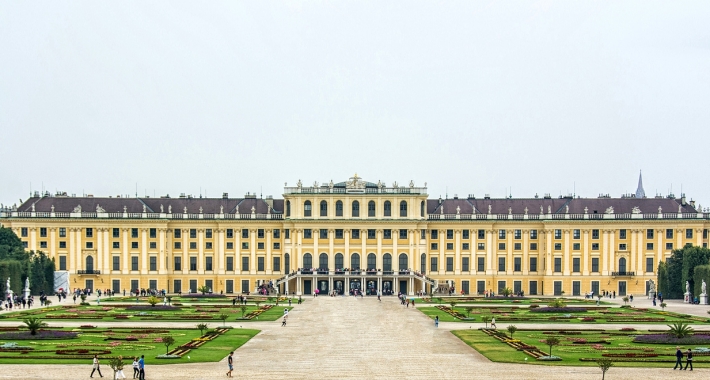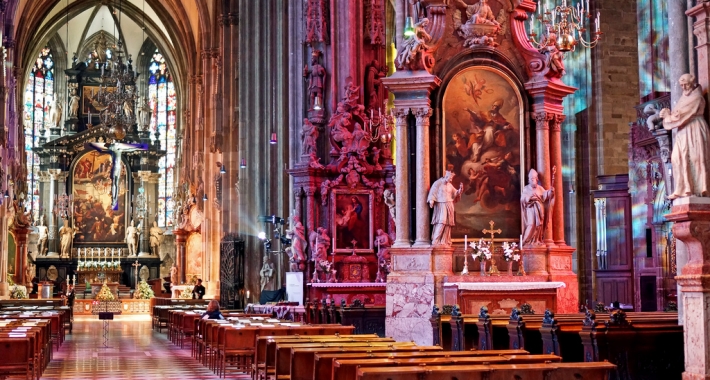Vienna in a Day
The best itinerary to see the most of what Vienna has to offer

Photo by Fèlix
In order to see Austria’s capital in a day, you’ll have to be prepared for a tour de force. Not only will you need some comfortable walking shoes, but you’ll need to make a solid plan that keeps in mind that you’ll unfortunately only see the bare minimum, and that you’ll need to leave some things behind.
It’s a very good idea to buy a daily ticket for all public transportation (it costs less than 7 euro) that can be found in every metro and train station. The pass will give you full access to buses, trains and trams within the city. You can find transport maps in any train station, at hotels, or at the Infopoint at Albertinaplatz.
Our ideal day begins with breakfast at any typically Viennese cafè where, alongside the usual cappuccino, you should order a slice of Strudel or a delicious Sacher torte (even though normally ordered in the afternoon). There are plenty of cafès, and we suggest to look for Konditorei Oberlaa, in the historic center in Neuer Markt (don’t worry, you’ll be back), or Cafè Mozart in Albertinaplatz. If you’re staying by Mitte/Landstrasse then Cafè Libeck will be a lot easier to get to (Metro, third stop Rochusgasse), otherwise if you’re by Westbahnhof/Mariahilferster go to Cafè Sperl, next to Karlsplatz.
After a nice breakfast you’re ready to explore the unforgettable Schonbrunn castle, accessible via metro on the U4, and experience a decisively Augsburgian atmosphere. It’s a tourist destination from around the world, starting with a huge park that ends in a Gloriette, a triple triumphal arch which faces the manor proper. You could just take pictures from the outside, but if you love history and Baroque architecture then you should definitely go in to see the magnificent rooms and halls that are still decorated with the imperial family’s heirlooms.
The castle doesn’t actually take too much time to visit, even though it’s a UNESCO World Heritage Site and the most visited monument in Austria. The entire complex, composed of the castle and surrounding grounds crafted in Baroque style, has been kept historically accurate through the years. Other interesting attractions are the Labyrinth and the Dedalus, as well as the children’s museum.
It’s a very good idea to buy a daily ticket for all public transportation (it costs less than 7 euro) that can be found in every metro and train station. The pass will give you full access to buses, trains and trams within the city. You can find transport maps in any train station, at hotels, or at the Infopoint at Albertinaplatz.
Our ideal day begins with breakfast at any typically Viennese cafè where, alongside the usual cappuccino, you should order a slice of Strudel or a delicious Sacher torte (even though normally ordered in the afternoon). There are plenty of cafès, and we suggest to look for Konditorei Oberlaa, in the historic center in Neuer Markt (don’t worry, you’ll be back), or Cafè Mozart in Albertinaplatz. If you’re staying by Mitte/Landstrasse then Cafè Libeck will be a lot easier to get to (Metro, third stop Rochusgasse), otherwise if you’re by Westbahnhof/Mariahilferster go to Cafè Sperl, next to Karlsplatz.
After a nice breakfast you’re ready to explore the unforgettable Schonbrunn castle, accessible via metro on the U4, and experience a decisively Augsburgian atmosphere. It’s a tourist destination from around the world, starting with a huge park that ends in a Gloriette, a triple triumphal arch which faces the manor proper. You could just take pictures from the outside, but if you love history and Baroque architecture then you should definitely go in to see the magnificent rooms and halls that are still decorated with the imperial family’s heirlooms.
The castle doesn’t actually take too much time to visit, even though it’s a UNESCO World Heritage Site and the most visited monument in Austria. The entire complex, composed of the castle and surrounding grounds crafted in Baroque style, has been kept historically accurate through the years. Other interesting attractions are the Labyrinth and the Dedalus, as well as the children’s museum.
The Cathedral of Santo Stefano, a Gothic masterpiece, is definitely worth the trip

Photo by Dennis Jarvis
After the castle, hop back on the U4 metro until you get to Kettenbruckengasse to take a walk through the Naschmarkt, Vienna’s most famous market, with over one hundred stands and locales to have lunch at. Your lunch will probably be wurstel based, from a wurstel stand (coleslaw, strong mustard and beer are also key).
Afterwards, if you walk to the end of the Naschmarkt you’ll bum pinto the Palace of Secession, where you can continue on to the Opera that’s at the beginning of the real historic center. Take Karntner Strasse to find the Gothic masterpiece of the Santo Stefano Cathedral, also known as the Stephansdom, worth at least a quick peek inside.
It’s recommended to follow Graben down to Hofburg, which once was the Augsburg’s imperial residence. It might also be interesting to visit the Spanish Equine School where many famous horses are reared, There’s not going to be enough time to go inside though, so direct yourselves back to the circular Ringstrasse that surrounds Vienna’s center, known by locals as “the ring”.
Afterwards, if you walk to the end of the Naschmarkt you’ll bum pinto the Palace of Secession, where you can continue on to the Opera that’s at the beginning of the real historic center. Take Karntner Strasse to find the Gothic masterpiece of the Santo Stefano Cathedral, also known as the Stephansdom, worth at least a quick peek inside.
It’s recommended to follow Graben down to Hofburg, which once was the Augsburg’s imperial residence. It might also be interesting to visit the Spanish Equine School where many famous horses are reared, There’s not going to be enough time to go inside though, so direct yourselves back to the circular Ringstrasse that surrounds Vienna’s center, known by locals as “the ring”.
There will be two seemingly identical museums, the Kunsthistorisches Museum of Art and the Naturhistorisches Museums of Natural History, both built during Imperial times. Nearby, you’ll also find the Rathaus, which is the main municipal building, and the Brugtheater, an imperial theater which is now one of the city’s universities.
If you’re still not satisfied with all this beauty, you can go back on the Freyung to have another Sacher at one of the traditional konditorei like Cafè Griensteidl. Later on, for dinner, you deserve a typical Austrian meal of craft beers, goulasch and Wiener Schnitzel. The best place to go would be Schottengasse 3, in the center, at Melker Stiftskeller. Locally known as a “heurige”, it’s a sort of folksy tavern.
Really, if you have any time left over you should check out Grinzing, the outskirts of the city, where there are all sorts of local taverns with their own specialties. And if you’re looking for nightlife, don’t forget about Spittelberg, a place you surely won’t forget anytime soon.
If you’re still not satisfied with all this beauty, you can go back on the Freyung to have another Sacher at one of the traditional konditorei like Cafè Griensteidl. Later on, for dinner, you deserve a typical Austrian meal of craft beers, goulasch and Wiener Schnitzel. The best place to go would be Schottengasse 3, in the center, at Melker Stiftskeller. Locally known as a “heurige”, it’s a sort of folksy tavern.
Really, if you have any time left over you should check out Grinzing, the outskirts of the city, where there are all sorts of local taverns with their own specialties. And if you’re looking for nightlife, don’t forget about Spittelberg, a place you surely won’t forget anytime soon.
Written by:
Aldo Galvagno
Translation by:
Translation by:
Daniel Yeatman

